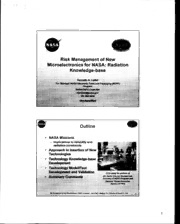
Risk Management of New Microelectronics for NASA: Radiation Knowledge-base PDF
Preview Risk Management of New Microelectronics for NASA: Radiation Knowledge-base
. . Risk Management of New Microelectronics for NASA: Radiation Knowledge-base m Outline NASA Missions - implications to reliability and radiation constraints Approach to Insertion of New Technologies Technology KnowleBge-base . . m - NASA Missions A Wide Range of Needs NASA typically has over 200 missions in some stage of development - Range frofn balloon and shortzluration lowearth investigations to long-life deep space - - Robotic to Human Presence Radiation and mliabifity needs vary commensurately Prior to the new Presidential “Moon-Mars” vision - >SO% of NASA missions required 100 krad(Si) or less for device total ionizing dose (TlD) tolerance Single Event Effects (SEES)w ere prime driver - Sensor hardness a ha limiting factor Many missions could accept risk of anomalies as longasmcuwabkovertime of the new W i na re StiflTBD for d iand diibiiity specifics, howewer, f#ucmrporrerJproputbioncha~tactirtion 2 Non-volatile Memory-related --- Single Event Trends NASA mission timeframes rarely allow for a technology development path - For a 2008 launch, for example, 3 @’ Insertion of New Technologies - An Approach Develop knowledge-base of existing technology information Determine relibilitylradiation gaps Performance ground-based - MaybezBufwmtto “qualify” for a specific rnission,butnotgenerically E . . - h P P Pr ogram Goals and Objective - Main goal Mission reliability and NASA science objectives - Ensure reliability missions by “smart” investments in technology knowledge gathering and research - Minimize engineering resources required to maximize space and earth sciencedata collection Radiationeffortsobjectives - Evalwte new and emerging technologies wifh a focus on near to mid tennnceds ~ E x p l l m ? ~ ~ . n d ~ ~ lkvelop guklelims for tsdylology usage, selection, and q u a l i IIlWWQaWrodkb. m hardmss assurance (RHA) issues 4 . . - NEPP Program Development In FYM, the NEPP Program began a new initiative to extend the knowledge-base of new microelectronicsf or NASA - Develop survey products documenting the cunent status of techndogies and ideqing the gaps ~ l u d s s S U W ~ ~ t h e ~ t b f t S O f n e W 8 ~ a n d t h d r Mlpl~form~tronksneeds With mga& to radiation knowledge, FYM surveys include: - - Transfomrational Communication ArcMecture NudewProputsion -#idebandgap- Changes in NEPP for FY03 vs. FY04: I - Advanced imaging and data collection radiation concerns & & & & & & I- 5 - NEPP Program Radiation Research FY04 The NEPP Program, due to funding constraints, has limited work in FYO4 on filling previously identied gaps in knowledge-base Efforts include: - TestGuidelinesltsssorwbmed Link Puaiifiution 1. Test a d2 Guide fa r) - - The Physics Models of Space - Radiation Environment to Target - Predictive model of the external External SpaI ce Environm/e nt space radiation environment that impinges on the spacecraft - Predictive model of the interaction of that environmentw ith the 6 - Existing ModelsKools Gaps for New Technologies Simple example citing tool limits - CREME96 AAssssuummppttiioonn ooff aa rreeccttaanngguullaarr ppaarraalllleellppiippeedd ((RRPPPP)) ffoorr sseennssiittiivvee vvoolluummee rreeqquuiirreess aasssseessssmmeenntt iinn lliigghhtt ooff -- SSiinnggllee BBvvMMtt ttrraannssiieenntt ((SSEETT)) iissssuueess ffoorr hhiigghheerr ssppeeeeddss --DDffffLLllddoonneeffffeeccttssnnootteeddiinnSSDDffUUMMss -- NNoonn--bbuullkkCCYYOOSStt&&rreeSSUUttbb Technology Tool “Gaps” Simplifying assumptions (such as RPP) used in many existing tools are inadequate for new technology performance - Use of existing tools for predictive purposes may add large risk factors onto NASA missions (significant under or over prediction of performance) - Physics-based models could provide a mom accurate solution using physics-modeling codes (GEANT4, MCNPX, etc.) Comprehensive tool suite is desired usirtg physics-based codes . . -and- n?8tizabb( Le., me to caiculslte I 7 @' Space Computational Radiation Interaction Performance Tools - (SCRIPT) Pieces of the Puzzle @ SCRIPT - Sample Gaps and Technology Dependent Implementation Issues taps exist in areas such o tow energy electrons, .- .- .. .. .. -.. . - .- .- .- .- .- ._-..- .- .- .. . - .-. -.- .-.. - .. .- .- .. . -... . .- ...-. solar heavy ions, a. Tests and Models 8 - Validation of SCRIPT Flight @ Experiments and Data . Differences exist between ground-based radiation tests and the actual space environment - Enwgyspectrum - Directionality - Wxedenvimnment - Particle arrivai rates (flux or -1 andior mitoring tschnology Perfwmanceare requiredB0 @' NASA's Living With a star (LWS) Space - Environment Testbed (SET) A Dual Approach to Flight Validation Data mining Flight experiments - The use of existing Right - Focusoncorrelating data to validate or develop technology (semiconductor improved models and to material) performame with tools sdar-variant space environment (radiation, UV, Examples - *.I Lineardevice * Wodclltaclndogyvdirhbkn P=f===em andnot~ntTd;3tion~ Microelectron-#;as n d - the- PhotmiiTestBed lrrsihtenviIwune& (Mpm m0naoringaakwAorgorad Summary Comments Technology needs to be planned for strategically - Long-term needs and not point solutions Mission risk revolves around radiation “unknowns” - Need a significante ffort in advance of mission timelines for new technology developmentftesting/modeling Infrastructuren eeds to be in place to support techndogb - Schedules don’tililawtimeforcrertii newupabititih.oncemission ddpIlaSStarted UpdptedBOols and modeis are required to reduce risk of 10
